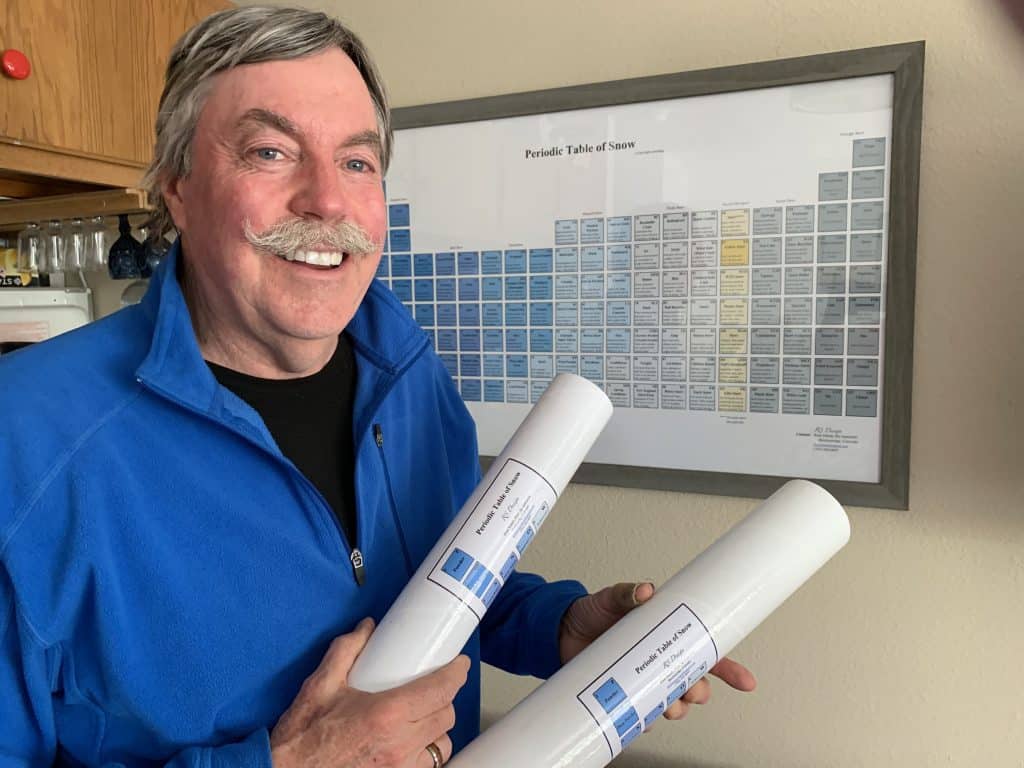Skiing slang: Periodic Table of Snow displays the unique side of winter language

Russ Scholl/Courtesy photo
“Free refills.” “Diamond dust.” “White suede.” “Cold smoke.”
For people who are not well versed in snowsports culture and slang, these are phrases that describe drinks at restaurants or a nice fabric. But for ski instructor Russ Scholl, collecting ski-area slang turned from a hobby into a small business. Scholl created the Periodic Table of Snow, which outlines dozens of snow terms that he’s collected in his four decades as a ski instructor.
“I often would have a notebook in my ski school parka. When I heard an unusual way of describing things about skiing, and in particular snow conditions, I jotted it down,” Scholl said. “That first spring of COVID, I was messing around writing a few of the short stories and got thinking about all these terms that I had collected — just shy of 50 of them. I don’t know where the idea came from, but early one morning, I thought about the periodic table of elements, how it’s organized and how it looks really kind of serious. Wouldn’t that be kind of funny to do this unusual twist on it?”

Casey Day/Loveland Ski Area
Now, snow enthusiasts from across the country have bought versions of Scholl’s periodic table, and versions of it can be found in shops in the town of Breckenridge. He worked with a local graphic designer, patented the design and created RS Designs to further share the table with skiers and snowboarders who want to display his work.
Scholl, who has taught students from Colorado to New England to Arizona and the mid-Atlantic region of the United States, said that there is not a whole lot of difference in the lingo used by skiers and boarders on the East Coast or Colorado. Though, there may be some discretion as to what they each consider good or bad conditions, which can then change what slang they would use. What a Coloradan skier may think is icy terrain could just be packed snow for a skier from New England.
“Obviously, the snow conditions are really wildly different,” Scholl said. “The average snow conditions that you would ski or ride in, in New England for instance, are quite different than in Colorado or Utah.”
Yet if conditions are right, Scholl said you can ski the best powder anywhere in the country.
“There are times when — I grew up in New Hampshire — I ski in Vermont, New Hampshire, Maine or Quebec that I have skied as good a powder in Colorado on the East Coast,” Scholl said. “Absolutely, no question about it. Now it doesn’t happen very often, maybe once a year.”
As for specific words that are only used in Summit County, Scholl said he has only heard the word “white suede” used in Colorado.
Snowhawk — describes the strip of snow left behind on the roof of a car during snowy months (resembles a mohawk)
Thundersnow — When the primary precipitation of a thunderstorm is snow instead of rain
Death cookies — large frozen lumps of snow created by poor grooming or avalanche debris
Creamed corn — a smooth blend of coarse niblets of snow between frozen, firm snow and slush
“That’s a condition where it’s like packed powder, but it’s packed by the wind. It’s not packed by any machines or anything,” Scholl said. “We often get it in Horseshoe Bowl off the T-Bar on Peak 8. It’s a great condition because it seems like it’s firm, but when you can set an edge very easily and curved, it’s just really smooth and kind of silky.”
Scholl has traveled across the state to showcase the table. Last year, he was invited to travel with the Warren Miller Film Tour, which made stops along the Front Range.
For Scholl, the table has become a way to share two loves: skiing and writing.
“I love words,” he said. “I love phrases and colorful language.”
Visit RSDesign.Group for more information.
This story originally published in the winter 2022-23 edition of Explore Summit magazine.

Support Local Journalism

Support Local Journalism
As a Summit Daily News reader, you make our work possible.
Summit Daily is embarking on a multiyear project to digitize its archives going back to 1989 and make them available to the public in partnership with the Colorado Historic Newspapers Collection. The full project is expected to cost about $165,000. All donations made in 2023 will go directly toward this project.
Every contribution, no matter the size, will make a difference.










